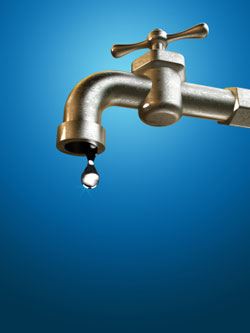
Water conservation at home is easy. Take one task at a time so it doesn’t seem overwhelming. If you are on a budget, start with the things that are free and work your way up.
Use your head
Examples of possible behavior changes that could save water in the bathroom include:
Taking 4-minute showers; turning the water off while shampooing your hair in the shower; turning water off while shaving or brushing teeth; and never using the toilet as a waste basket.
Other simple behavior changes can save a lot of water in the kitchen and laundry area. In the kitchen: keep drinking water in the refrigerator instead of letting the faucet run until the water is cool; thaw food in the refrigerator overnight rather than running hot water over it; scrape rather than rinsing dishes when loading the dishwasher; and add food waste to a compost pile instead of using the garbage disposal. In the laundry area, wash only full loads of laundry, or use the appropriate water level or load size selection on the washing machine.
Outdoors; sweep sidewalks and driveways rather than hosing them off; use soaker hoses and or drip systems rather than sprinklers to avoid evaporation; and wash the car with water from a bucket to keep the hose from running constantly, or consider using a commercial car wash that recycles water.
Leaks
Make sure your home is leak-free. Check indoor water-using appliances and devices for leaks. Many leaks allow water and your money to go down the drain.
Dripping faucets that are leaking at a rate of one drop per second can waste 2,700 gallons of water per year. Not only is this a waste of water, it adds to the size of your water and it puts a strain on your septic system.
Toilet tank leaks account for much of the water wasted in homes. A leaky toilet can waste 200 gallons per day. Check for toilet tank leaks by adding food coloring to the tank. If the toilet is leaking, color will appear in the bowl within 30 minutes. Most replacement parts are inexpensive, readily available, and easily installed.
Another large water waster can be irrigation system leaks; fix these leaks quickly.
Appliances, toilets, and faucets
Homes with high-efficiency plumbing fixtures and appliances save about 30 percent of indoor water use and yield substantial savings on water, sewer, and energy bills (EPA). Below are some examples of changes that can be made.
The toilet is the largest water user in your home. Most toilets installed before 1992 do not have the water-saving 1.6 gallon per flush. For those toilets that do make the flush efficient, hold the lever down to complete the flush cycle, which alleviates the need for a second flush.
Make sure all shower heads release 2.5 gallons per minute or less. Today, all shower heads sold are regulated to meet the 2.5 gallons per minute maximum requirement. To make the flow feel like more water is coming out, turn the head dial to reduce the number of sprays or inner spray settings.
Replace your clothes washer – it is the second largest in-home water user. Energy Star™ rated washers, which also have a Water Factor at or lower than 9.5, use 35 to 50 percent less water and 50 percent less energy per load (EPA), saving you money on both water and energy bills.
Landscaping
From 50 to 75 percent of a home’s total water use during the growing season may be for outdoor purposes. It’s important that you develop a plan or convert your current landscape to include plants and design that are appropriate for your climate conditions.
If you have an irrigation system, it also needs to be regularly adjusted and checked for leaks.
Select plants that are appropriate for your local climate conditions. Having a yard with 100 percent lawn turf area in a dry climate uses significant amounts of water. Use only the amount of water that your plants need.
Water during the coolest part of the day. Use soaker hoses or trickle irrigation for trees and shrubs. Don’t water plants that do not need the water. Be attentive to your watering time.
Maintain your irrigation system. Make sure your irrigation controller has a rain shutoff device. Water trees and shrubs longer and less frequently than shallow-rooted plants.
Mulch around shrubs and garden plants to reduce evaporation from the soil surface and to cut down on weed growth.
